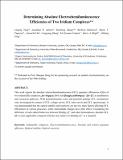Files in this item
Determining absolute electrochemiluminescence efficiencies of two iridium complexes
Item metadata
| dc.contributor.author | Yang, Liuqing | |
| dc.contributor.author | Adsetts, Jonathan R. | |
| dc.contributor.author | Zhang, Ruizhong | |
| dc.contributor.author | Balónová, Barbora | |
| dc.contributor.author | Piqueras, Marta T. | |
| dc.contributor.author | Chu, Kenneth | |
| dc.contributor.author | Zhang, Congyang | |
| dc.contributor.author | Zysman-Colman, Eli | |
| dc.contributor.author | Blight, Barry A. | |
| dc.contributor.author | Ding, Zhifeng | |
| dc.date.accessioned | 2022-11-19T00:40:21Z | |
| dc.date.available | 2022-11-19T00:40:21Z | |
| dc.date.issued | 2021-11-19 | |
| dc.identifier | 276830698 | |
| dc.identifier | fa1cbd3f-8003-4bc3-9426-4a59209291cd | |
| dc.identifier | 85119936320 | |
| dc.identifier | 000767853100007 | |
| dc.identifier.citation | Yang , L , Adsetts , J R , Zhang , R , Balónová , B , Piqueras , M T , Chu , K , Zhang , C , Zysman-Colman , E , Blight , B A & Ding , Z 2021 , ' Determining absolute electrochemiluminescence efficiencies of two iridium complexes ' , Journal of Electroanalytical Chemistry , vol. In press , 115891 . https://doi.org/10.1016/j.jelechem.2021.115891 | en |
| dc.identifier.issn | 1572-6657 | |
| dc.identifier.other | RIS: urn:A6AB39135BA141E3E61B426DAC1E5A9C | |
| dc.identifier.other | ORCID: /0000-0001-7183-6022/work/103865679 | |
| dc.identifier.uri | https://hdl.handle.net/10023/26442 | |
| dc.description | This work is financially supported by Natural Sciences and Engineering Research Council Canada (NSERC, DG RGPIN-2018-06556 and SPG STPGP-2016-493924), Canada Foundation of Innovation/Ontario Innovation Trust (CFI/OIT, 9040) and The University of Western Ontario. E. Z.-C. is a Royal Society Leverhulme Trust Senior Research fellow (SRF\R1\201089). | en |
| dc.description.abstract | This work reports absolute electrochemiluminescence (ECL) quantum efficiencies (QEs) of two iridium(III) complexes, fac-Ir(ppy)3 (Ir-1) and [Ir(ppy)2(dtbubpy)]+ ([Ir-2]+) in annihilation and coreactant pathways. With potentiodynamic scans and potential pulsing, ECL mechanisms were investigated by means of ECL-voltage curves, ECL-time curves and ECL spectroscopy. It was demonstrated that the radical stability and reactivity are the two main factors affecting ECL efficiencies in various processes, while intermediate charges have little effect. Considering the difference of such radical behaviors between [Ru(bpy)3]2+ and other luminophores, absolute ECL QEs are more applicable compared with the ones relative to [Ru(bpy)3]2+ as a standard. | |
| dc.format.extent | 1210080 | |
| dc.language.iso | eng | |
| dc.relation.ispartof | Journal of Electroanalytical Chemistry | en |
| dc.subject | Iridium(III) complexes | en |
| dc.subject | Electrochemiluminescence | en |
| dc.subject | Absolute and relative quantum efficiency | en |
| dc.subject | Radical stability | en |
| dc.subject | Radical reactivity | en |
| dc.subject | QD Chemistry | en |
| dc.subject | E-NDAS | en |
| dc.subject.lcc | QD | en |
| dc.title | Determining absolute electrochemiluminescence efficiencies of two iridium complexes | en |
| dc.type | Journal article | en |
| dc.contributor.sponsor | The Royal Society | en |
| dc.contributor.institution | University of St Andrews. School of Chemistry | en |
| dc.contributor.institution | University of St Andrews. EaSTCHEM | en |
| dc.identifier.doi | https://doi.org/10.1016/j.jelechem.2021.115891 | |
| dc.description.status | Peer reviewed | en |
| dc.date.embargoedUntil | 2022-11-19 | |
| dc.identifier.grantnumber | SRF\R1\201089 | en |
This item appears in the following Collection(s)
Items in the St Andrews Research Repository are protected by copyright, with all rights reserved, unless otherwise indicated.

